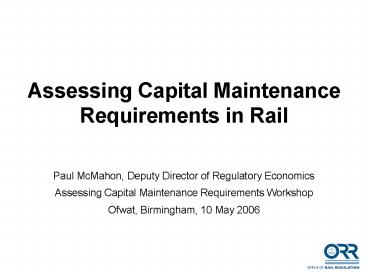Assessing Capital Maintenance Requirements in Rail - PowerPoint PPT Presentation
1 / 13
Title:
Assessing Capital Maintenance Requirements in Rail
Description:
Vertical separation of infrastructure and train operations ... Hatfield exposed inadequacies in asset management and led to: Temporary speed restrictions ... – PowerPoint PPT presentation
Number of Views:54
Avg rating:3.0/5.0
Title: Assessing Capital Maintenance Requirements in Rail
1
Assessing Capital Maintenance Requirements in Rail
- Paul McMahon, Deputy Director of Regulatory
Economics - Assessing Capital Maintenance Requirements
Workshop - Ofwat, Birmingham, 10 May 2006
2
Structure of presentation
- Rail industry structure
- Potted history of key relevant developments
- Asset management
- Comparison to water
3
Context industry structure
- Privatised in 1996
- ORR is independent economic and safety regulator
- Broadly conventional incentive based economic
regulation structure, but key differences to
water - Vertical separation of infrastructure and train
operations - Franchises (which do not run concurrently with
control periods) - Franchisees insulated from changes to charges
during franchise lifetime and have limited
commercial flexibility - Significant amounts of public subsidy
- New process for conducting periodic reviews
- Network Rails structure (CLG, FIM)
4
From privatisation to Hatfield
- Railtrack - key issues and concerns
- Lack of asset knowledge
- Antagonistic relationships
- Poor approach to outsourcing
- ORR growing concerns, including incidence of
broken rails - 2000 periodic review
- ORR very critical of information available
- Included licence condition 24 (asset register)
- Hatfield accident occurred two days before
planned publication of PR2000 conclusions in
October 2000 Potters Bar accident occurred in
2002
5
After Hatfield
- Hatfield exposed inadequacies in asset management
and led to - Temporary speed restrictions
- Significant (inefficient) re-railing (overspend
of gt6bn) - Railtrack went into administration in October
2001 - Network Rail took over Railtrack in October 2002
- 2003 access charges review
- Significant increase in funding for asset
maintenance and renewal - but significant efficiency challenge
- Bottom-up review of workbanks and review of NR
models/processes - Established clear output targets for performance
and asset condition - Monitoring framework enhanced
- Network Rail is improving asset knowledge, asset
condition, operational performance and cost
control
6
Rail renewal volumes
7
Railtrack/Network Rail opex, maintenance and
renewals expenditure (forecast from 2005/06)
8
Network Rails Business Planning Criteria
- Published/developed under licence condition 7 on
network stewardship - Set out Network Rails role and processes for
asset management - Published on NR website
- Not as sophisticated as CMF
- More work necessary as part of 2008 periodic
review
9
Asset policies
- Central to the Business Planning Criteria
- Set out maintenance/renewals regime for each
asset type to deliver the outputs - Network Rail see these as being consistent with
PAS55 - Include Network Rails risk management framework
- Recognise funding and deliverability constraints
- Draw on modelling tools
- Need to be developed/finalised for PR08
10
Rail asset management comparison with PAS55
- Forward looking long term demand forecasting of
traffic and degradation still difficult to
predict - Data supported Asset knowledge still deficient
- Whole life cost / optimisation To an extent
this takes place but have been funding
constraints - Risk based Standards driven to a large extent
- Continued improvement Network Rail Business
Planning Criteria (and underlying policies,
models, etc) do reflect this but still a way to
go - Pragmatic A dominant feature in rail (funding
and delivery constraints)
11
Network Rail key challenges for developing robust
plans for PR08
- Complete and implement asset management
planning/business planning criteria - Improve its understanding of cost causation
- Improve the transparency and robustness of
expenditure forecasts, relating them to relevant
measures of activity and output - Consider explicitly passenger demand forecasts
- Develop companys own view of its efficiency and
the scope for improvement - Provide more geographically disaggregated
activity, output and expenditure forecasts.
12
Finally, a brief comparison with water
- Major differences
- Safety critical (knife-edge)
- Very high public profile rail has had a
difficult 10 years - Significant deficiencies in asset knowledge
- No (few) comparators
- How have we/industry dealt with this?
- More frequent and intrusive monitoring
- Asset register licence condition
- Hatfield triggered significant research into cost
causation - Improving Business Planning Criteria and
modelling tools - Reporters currently assessing Network Rails
asset management tools and processes for PR08,
includes assessment of key asset life and
degradation assumptions
13
- Thank you. Any questions?
- www.rail-reg.gov.uk































